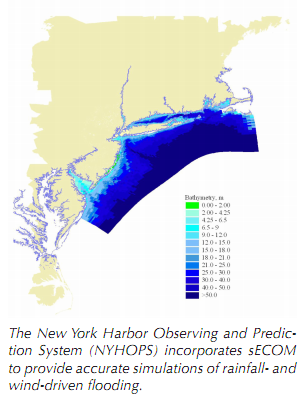- Home
- About
- Stakeholders
- Projects
- Water
- Evaluating reservoir operations and the impacts of climate change in the Connecticut River Basin
- Collaborative development of climate information for the Connecticut River Basin using Shared Vision Forecasting
- Impacts of climate change on the Massachusetts Water Resources Authority water supply system
- Climate information for water harvesting and re-use strategies in urban settings
- Delaware River streamflow reconstruction using tree rings
- Coasts
- Health
- Cross-cutting theme: Climate
- Cross-cutting theme: Vulnerability/Evaluation
- Water
- Library
- Resources
- Seminars
- Contact Us

Accurate extra-tropical storm surge modeling: The influence of model dimensionality, freshwater inputs, tides, and model grid area
 Research is being conducted with the primary objective of evaluating what components of a highly detailed coastal ocean model, the sECOM hydrodynamic model [e.g., Blumberg and Georgas, 2008], are important for predicting storm surge flooding, and what aspects have negligible influence. The research utilizes a highly detailed hydrodynamic modeling system that has been demonstrated to provide highly accurate storm surge predictions in an operational context. The experiments will add and remove several components of the model’s inputs and capabilities, including (1) two-dimensional (parameterized) versus three-dimensional (fully dynamic) modeling, (2) including rain and freshwater inputs, (3) nesting the model inside a larger-scale ocean model, and (4) including tides. Three storms from March through April 2010 are being modeled: one storm with wind and rain, another with only rain, and one intermediate case. The first storm caused the largest surges in the New York City area since 1992, at 1.2 m, and the other two caused minor surges there; all three storms caused high water levels at Albany, up the Hudson River.
Research is being conducted with the primary objective of evaluating what components of a highly detailed coastal ocean model, the sECOM hydrodynamic model [e.g., Blumberg and Georgas, 2008], are important for predicting storm surge flooding, and what aspects have negligible influence. The research utilizes a highly detailed hydrodynamic modeling system that has been demonstrated to provide highly accurate storm surge predictions in an operational context. The experiments will add and remove several components of the model’s inputs and capabilities, including (1) two-dimensional (parameterized) versus three-dimensional (fully dynamic) modeling, (2) including rain and freshwater inputs, (3) nesting the model inside a larger-scale ocean model, and (4) including tides. Three storms from March through April 2010 are being modeled: one storm with wind and rain, another with only rain, and one intermediate case. The first storm caused the largest surges in the New York City area since 1992, at 1.2 m, and the other two caused minor surges there; all three storms caused high water levels at Albany, up the Hudson River. Initial Results: The research is in its relatively early stages, but one important finding is that the New York Harbor Observing and Prediction System (NYHOPS), the operational system that utilizes the sECOM model with all available detailed inputs, accurately simulates the merging of rainfall- and wind-driven flooding on the Hudson River. This is important because hydrology and oceanography have generally not been dynamically merged in prior efforts at flood modeling.
For more information on NYHOPS, please visit this site: http://stevens.edu/maritimeforecast .
Investigators: Alan Blumberg, Julie Pullen, Philip Orton, Nickitas Georgas
